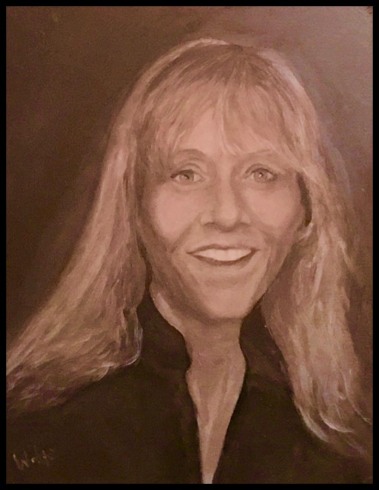
For the last three months, I have been working on a portrait. It is still in process; an unfinished, challenging, ongoing, all-encompassing activity. In fact, it is a series of problem-solving steps. Every brush stroke is a considered motion. Ahead of that, there is the choice of hue, value, and type of brush for each stroke.
Yet, before I even contemplated the paint colors, I needed to have a vision of what I wanted to paint. After some time spent looking through photographs (life model was not available), I made my decision. Finally, I knew what I wanted to paint, who I wanted to paint, and what I wanted the painting to look like when I finished.
This brings me to today. Just as with any creative process, there is labor. Oil painting is something I love to do; nevertheless, there is frustration and aggravation. When I am not painting, my mind often wanders back to the canvas. In fact, I take several photos so that I can examine the current state of my painting. What can I do better? Where are the problems? How can I improve the image?
I have probably wiped down and scraped off more paint than is currently on the canvas. In fact, I am positive of it. Some of what I rubbed off was good. Indeed, one image was beautiful. Nevertheless, it did not reflect my plan. A portrait is more than capturing the likeness of the person; it is an attempt to capture the character of the individual.
We have all see portraits of dignitaries or famous people. Have you ever noticed the tilt of the head, what they are holding in their hands, what type of clothing they are wearing? All of it is designed to convey an important fact. The intention of the artist and individual is for you to know an answer to a “who” question. That big consuming question for so many of us.
All of this got me to thinking: our lives are canvases. We began life with an image already imprinted before any paint was applied. Upon birth, our parents started to add the paint with their brushes. They took a beautiful plan and added to it. Some of what they applied was solid and worth keeping. Much of it needed to be wiped off – maybe, it needed to be scraped off.
As you matured, you also began to add to your image. Eventually, at some point, you took the brush out of the master’s hand. Formulating a plan in your head, you changed the image. You might even have painted something beautiful – probably not. After awhile, your portrait started to have problems. You started to ask yourself What can I do better? Where are the problems? How can I improve?
At this point in your life, you might be struggling with a disability or some other difficulty. They are wayward strokes. Unlike other times when you could wipe down or scrape off unwanted “paint,” these strokes are permanent changes. It could be that the problems have helped you to focus on what needs to be changed. Maybe, you are finding that your troubles are developing your character. As we examine our lives, we are afforded the opportunity to stand back and unearth the original vision. The discovery process, the hard work and frustration, is answering the “who” question.
It may not be a neurotypical life; it may not be what you or I envisioned for our lives. Nevertheless, the portrait is not to be trashed. Your character will shine through. There is still a beautiful portrait sitting there – unfinished.

The eyes are brilliant, they have a fun spark! And, the smile and chin are like yours 🙂
Your post makes me thoughtful.
🐻 💜 🎨 🌹
LikeLike
Thank you, dearest. It is getting there. (The original is better, but it is too wet to take a photo with the lights on. Too much glare from the oil.) I am enjoying the process. The lessons learned are multifaceted. Hugs.
LikeLiked by 1 person
I remember the wonderful oil smells from my grandad’s room…
It must be a real pleasure painting. Your sister will love it, Rose 🙂
Love + hugs
LikeLiked by 1 person
The feel and smell of the oils are sensual pleasures in and of themselves. They are addictive. Thank you. (I hope so.)
LikeLiked by 1 person
Beautiful Rose 🙂
LikeLiked by 1 person
😘
LikeLiked by 1 person